The Viking Ship Museums: A Journey Through Maritime Heritage
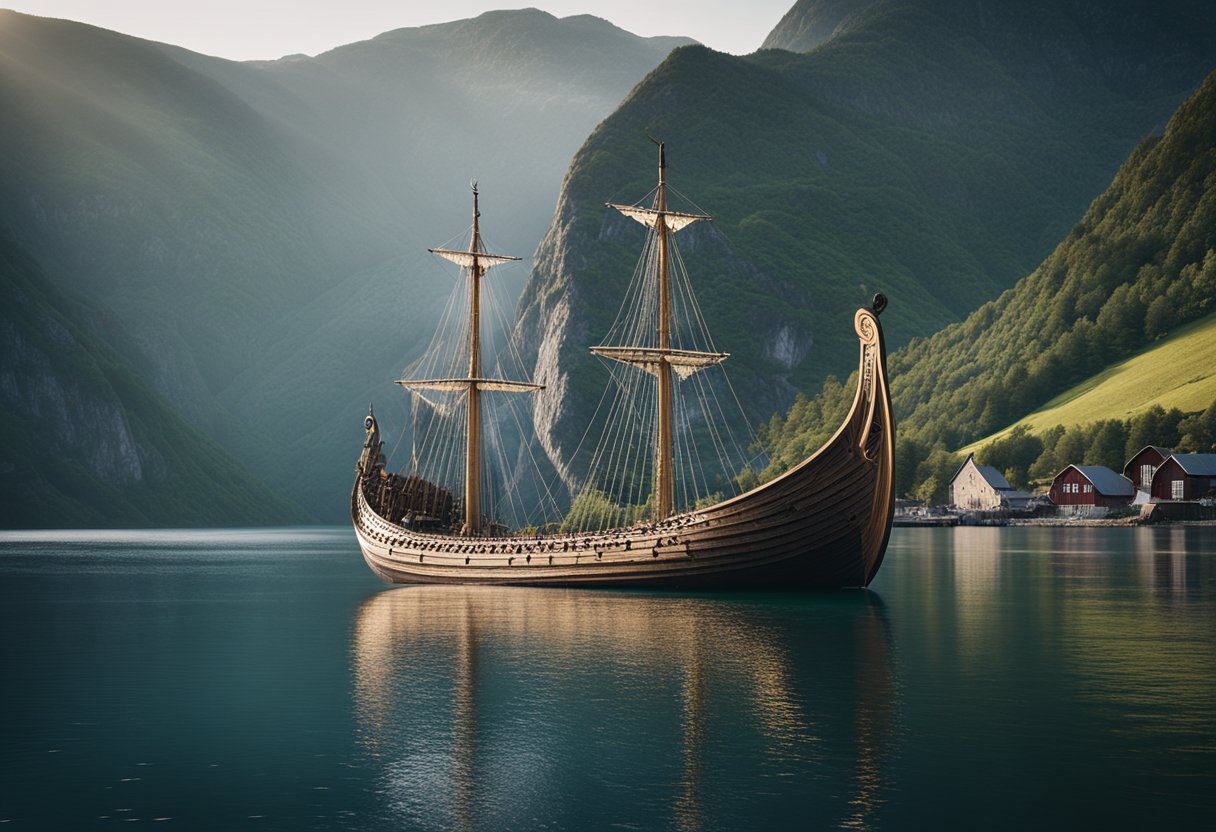
Updated On: April 23, 2024 by Yomna Salah
The Viking Ship Museums offer an immersive portal into the lives and legacies of the Vikings, seafaring people who made an indelible impact on European history. These museums safeguard not just maritime vessels but a treasure trove of insights into Viking society, trade, and culture. They serve as custodians of history, showcasing the intricate craftsmanship of the Vikings and their iconic ships, pivotal in exploration, trade, and warfare. Through these exhibits, we come to understand the complexities of Viking society and their contributions to contemporary civilisation.

Anchored within these museums are the remarkable archaeological finds, such as the Oseberg ship, which provide answers to centuries-old questions about the Vikings. We observe the evolution of shipbuilding techniques, the wide array of cultural artefacts, and the significant role of these vessels in the sacred burial rituals of the Vikings. Each artefact and exhibit enhances our comprehension of the extensive Viking trade networks and their expansion across the known world. As we traverse through the halls, we witness a story that extends far beyond conquest—an intricate narrative of innovation, artistry, and human endeavour.
Conservation of these ancient relics involves sophisticated techniques to ensure their survival for future generations. Museums facilitate this, acting as gatekeepers of the past, while their architecture and design pay homage to the past, often creating a dialogue between the modern world and ancient times. Concurrently, we recognise how the Viking legacy continues to inspire contemporary design and craft, underscoring our connection to this enigmatic era.
Table of Contents
Viking Origins and Society
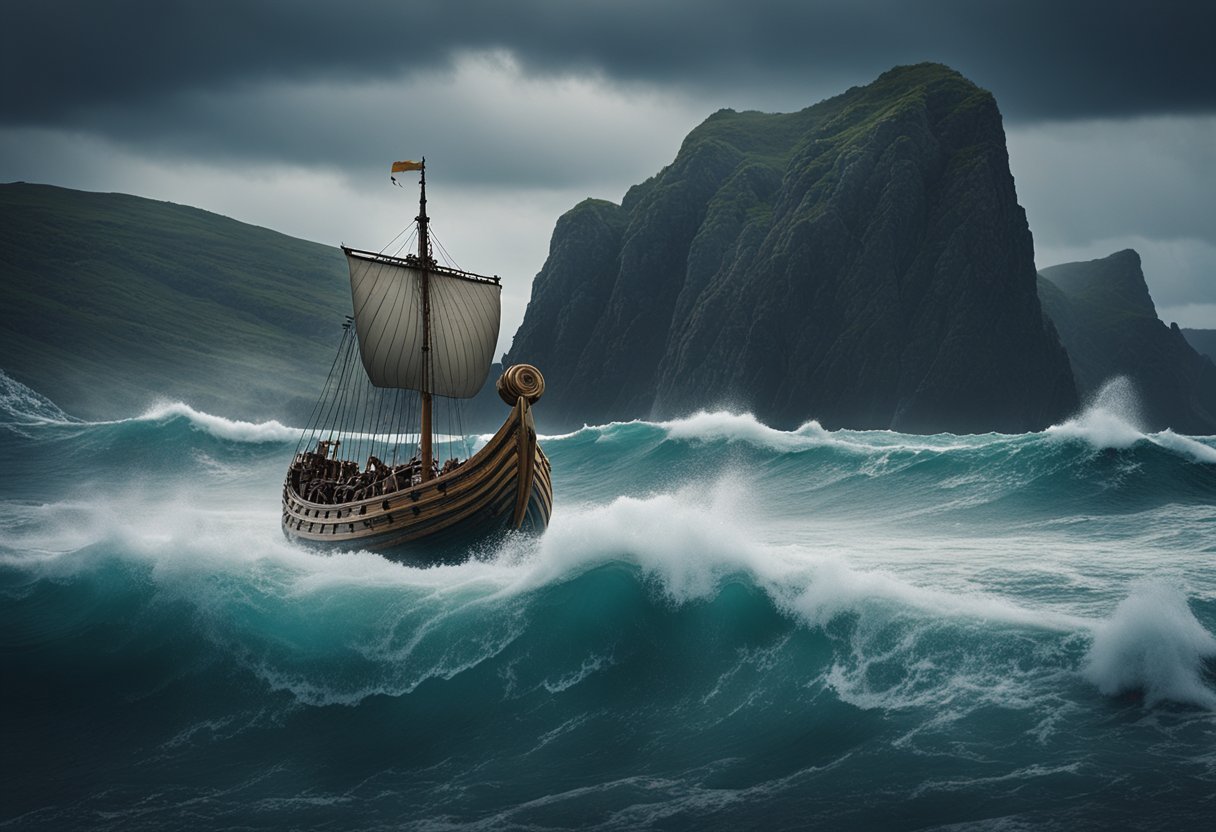
The Viking Age marks a significant period in history, usually defined as spanning from the late 8th century to the early 11th century. It was during this era that Vikings from Scandinavia embarked on various seafaring expeditions, both for trade and conquest. The term ‘Viking’ itself is believed to have originated from the Old Norse word ‘víkingr’, signifying a sea warrior or pirate.
Strictly speaking, the Viking society was divided into several classes:
- The Jarls: The wealthiest and most powerful, often landowners or leaders.
- The Karls: The free common people, including farmers, artisans, and merchants.
- The Thralls: The slaves which were a consequence of warfare and raids.
Their society was deeply connected to the sea, with shipbuilding being a highly respected and sophisticated craft. Maritime prowess was a cornerstone of Viking identity, with their ships being symbols of power and a means for exploration, as well as trade and warfare.
Vikings were often associated with raids on monasteries and towns, but they also established extensive trade networks. Evidence of their reach can be seen through artefacts found across the old world, from the British Isles to the Eastern Byzantine Empire and beyond.
Viking beliefs and governance structures were equally intricate, characterised by assemblies known as things, where free men would gather to make laws and resolve disputes. Their pantheon of gods, including Odin, Thor, and Freya, underpinned a rich mythology that influenced daily life and cultural practices.
Today, their legacy lives on in museums such as the Museum of the Viking Age and The Viking Ship Museum in Roskilde, which house restored vessels and artefacts, offering us insight into the complex and multi-faceted society of the Vikings.
Evolution of Viking Ships
In tracing the evolution of Viking ships, we observe the transition from pragmatic, plain oak planks to structures of beauty and terror on the water. Initially, these vessels were simple, but they evolved into the iconic longships that are so closely associated with the Vikings’ prowess in seafaring.
Longships, recognised by their slender form and symmetrical prow at each end, were feats of maritime engineering. The construction of these ships utilised the clinker method, where planks were overlapped and riveted together, creating a strong yet flexible hull. Here are some pivotal features:
- Hull Design: Made from oak, known for its durability and resistance to decay, Viking ships were crafted to withstand the harshness of the northern seas.
- Keel: The keel is robust and integral to the vessel, allowing for greater stability and effective manoeuvrability.
- Sails: Though initially relying on oars, the introduction of the sail empowered Vikings to travel longer distances with less effort.
Their evolution matched their needs, from local trade to exploration and even raiding. Below is a summary of the transformations:
| Era | Development | Purpose |
|---|---|---|
| Pre-Viking Age | Simple boats | Fishing and minor trading |
| Early Viking Age | Introduction of prow artwork | Symbolising strength |
| Viking Age Peak | Longships with sails | Exploration, trade, and warfare |
Our understanding of these ships has been significantly enriched by the findings at sites such as the Oslo Viking Ship Museum, which has uncovered varying ship types, each signifying different uses and statuses.
Among the most majestic remains are those of the Oseberg ship, discovered in a large burial mound at the Oseberg farm near Tønsberg in Vestfold county, Norway. This ship, now housed in the Viking Ship Museum in Oslo, showcases the intricate woodwork and artistry that went into these ships, a testament to the Viking Age’s advanced craftsmanship and aesthetic sensibilities.
The Significance of the Oseberg Find
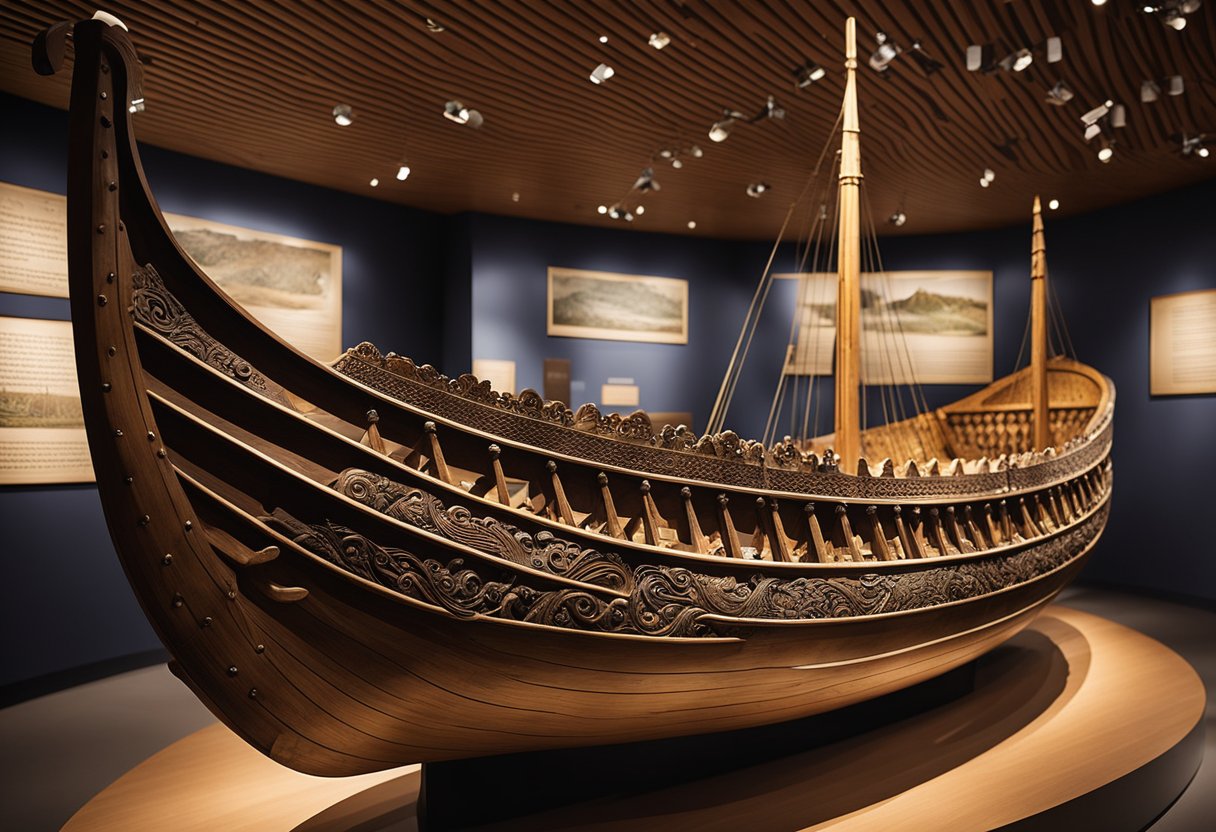
We regard the Oseberg find as one of the most important in the study of Viking history and archaeology. This significant discovery, made in 1904, comprises a burial site where a grand Viking ship was unearthed. Inside the ship, lavish grave goods were found alongside the remains of two women, hinting at the high status they once held, potentially even one being the famed ‘Queen of Oseberg.’
This find gave us unprecedented insights into Viking shipbuilding, artisanship, and the customs surrounding death and the afterlife during the Viking Age. The detailed craftsmanship of the ship itself demonstrated the sophisticated skills of the Norse shipbuilders. Furthermore, the preservation of the Oseberg ship provided a crucial reference for reconstructing and understanding Viking ship architecture.
The Oseberg ship contained an array of artefacts, including intricately carved wooden objects, textiles, and tools that have contributed significantly to our knowledge of the Viking era. Even the animals found at the site, such as horses and dogs that accompanied the deceased, lend credence to the rituals and beliefs of the time.
Moreover, the excavation process provided valuable data on conservation techniques, which continue to influence modern archaeological methods. Each artefact, bone, and textile unearthed has contributed to a richer, more textured understanding of the diverse Viking culture.
The Oseberg find, therefore, is not just a collection of objects and a ship; it represents a physical narrative that continues to captivate us, prompting ongoing exploration and conservation efforts that let us voyage through history.
Discoveries at Gokstad and Tune
In the realm of Viking Age archaeology, the findings at Gokstad and Tune stand as paramount discoveries. We take great pride in the archaeological excavations that have shed light on our seafaring ancestors.
Gokstad: The Gokstad ship, uncovered in 1880 on the Oslofjord’s shores, is a magnificent specimen of Viking craftsmanship. This ship, which dates back to the 9th century, was found within a burial mound at Gokstad in Sandar, Sandefjord, Vestfold, Norway. It is the largest preserved Viking ship in Norway and represents the zenith of Viking navigation and shipbuilding technology. The Gokstad ship can now be marvelled at in the Viking Ship Museum in Oslo, which testifies to its significance as a cultural artefact (Museum of the Viking Age).
Tune: Similarly, the Tune ship signifies another monumental archaeological find, excavated in 1867 on a farm island near Fredrikstad in southeast Norway. It was the first Viking ship to be discovered by archaeologists in Norway. The ship was found in an exceptionally large burial mound and is notable for the speed that its design suggests. The Tune ship currently enjoys prominence at the Viking Ship Museum (Life in Norway).
We continue to learn from these excavations, as they provide us with profound insights into the Viking Age and the seafaring prowess that characterized this fascinating epoch in history.
Architectural Marvels: Museums and Preservation
At the Viking Ship Museum in Bygdøy, we witness an extraordinary intersection of preservation and architecture. Designed by Arnstein Arneberg, the museum is a shining example of the Nordic neo-baroque style, with a grandeur that harks back to the medieval Romanesque and Gothic traditions. Arneberg’s work masterfully encapsulates a period where attention to detail was paramount, ensuring that these ancient vessels received a fitting home.
In keeping with our dedication to safeguarding history, the museum also plays a significant role as part of the Museum of the Viking Age, which falls under the purview of the larger Museum of Cultural History. Here’s a snapshot of the museum’s significance:
| Year Established | Purpose | Significance |
|---|---|---|
| Early 20th Century | Preservation of Viking Vessels | One of the finest examples of Viking heritage |
The museum’s longevity has become a testament to the importance of architectural excellence in preservation. Anticipating the future, an architectural competition laid out plans for the museum’s expansion from 2023 to 2030. This highlights our commitment to innovation in museum design, ensuring continued preservation of the irreplaceable artefacts from the Viking Age.
By maintaining a balance between historical reverence and modern progression, we assert our role in the global dialogue on cultural sustainability. Our objective is not just to display artefacts but to envelop our visitors in the aura of the Viking legacy, preserved within architectural marvels that stand as guardians of history.
Cultural Artefacts and Exhibits
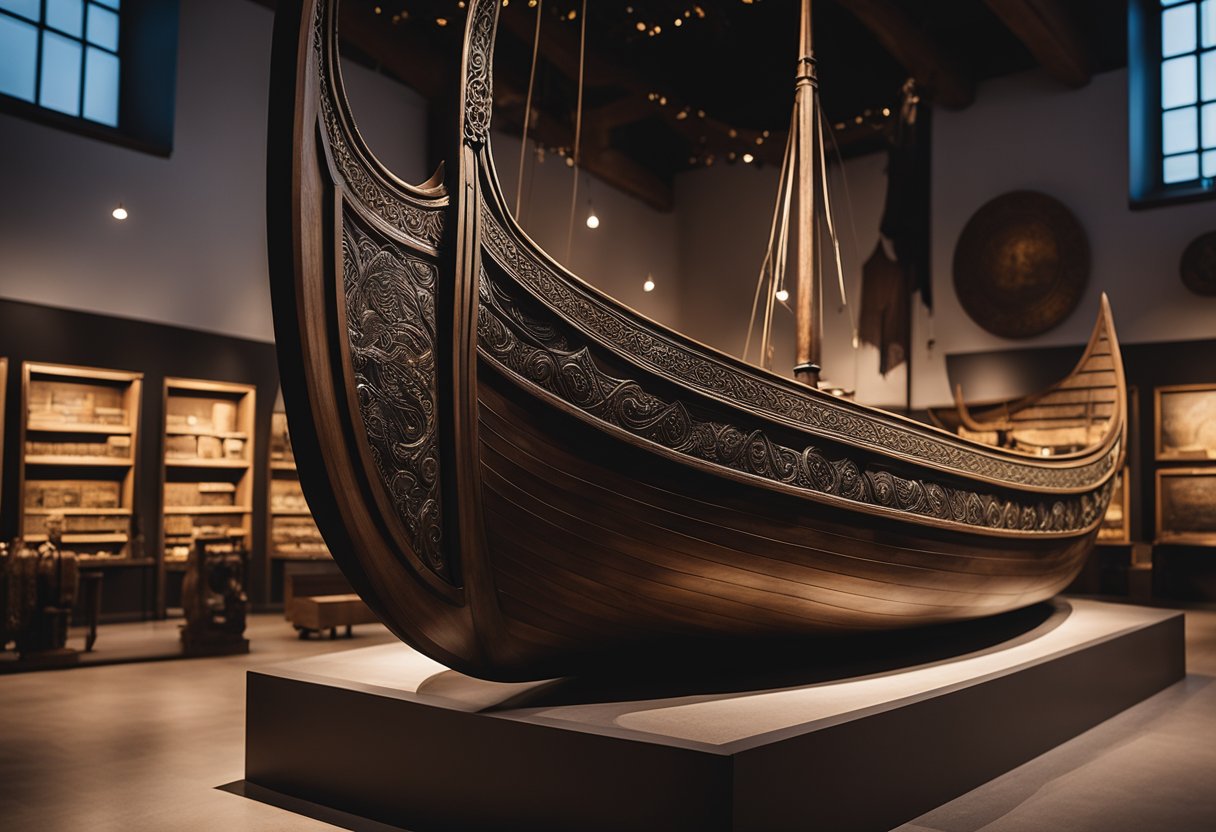
In exploring the rich tapestry of Viking history, we encounter a wealth of cultural artefacts and exhibits that bring this bygone era to life. The Viking Ship Museum in Roskilde presents a remarkable display that captures the essence of the Viking Age, from the intricacies of maritime technology to the personal belongings of the Viking people.
Our journey begins with the ships themselves, preserved and showcased as the centrepieces of the museum. It’s here we appreciate the craft of shipbuilding—how each oak plank and iron rivet contributed to the vessels’ seafaring prowess. Alongside these iconic ships, a variety of grave goods invites us to ponder the lives of those they accompanied in burial, hinting at a society rich in ritual and reverence for the afterlife.
Multiple exhibits disclose the presence of items such as beds, sleighs, tents, and carts, underscoring the unexpected domestic side of the Viking culture. Through these objects, we grasp a snapshot of everyday life, from transport to household activities. Gabriel Gustafson’s contributions to the field are evident as we witness the meticulously curated collection within the Historical Museum.
Here is a brief overview of what we may encounter:
- Ships: Magnificent oak constructions showcasing Viking craftsmanship
- Grave Goods: Items accompanying the deceased, from weaponry to jewellery
- Everyday Objects:
- Beds and sleighs: Insight into Viking domestic life and winter transport
- Tents and carts: Indicative of trade, travel, and military campaigns
By presenting these exhibits, we establish a connection with a civilisation renowned for exploration and conquest yet abundantly complex in its customs and day-to-day existence. The artefacts tell tales of innovation, artistry, and community—a truly multifaceted historical experience.
Understanding Viking Trade and Expansion
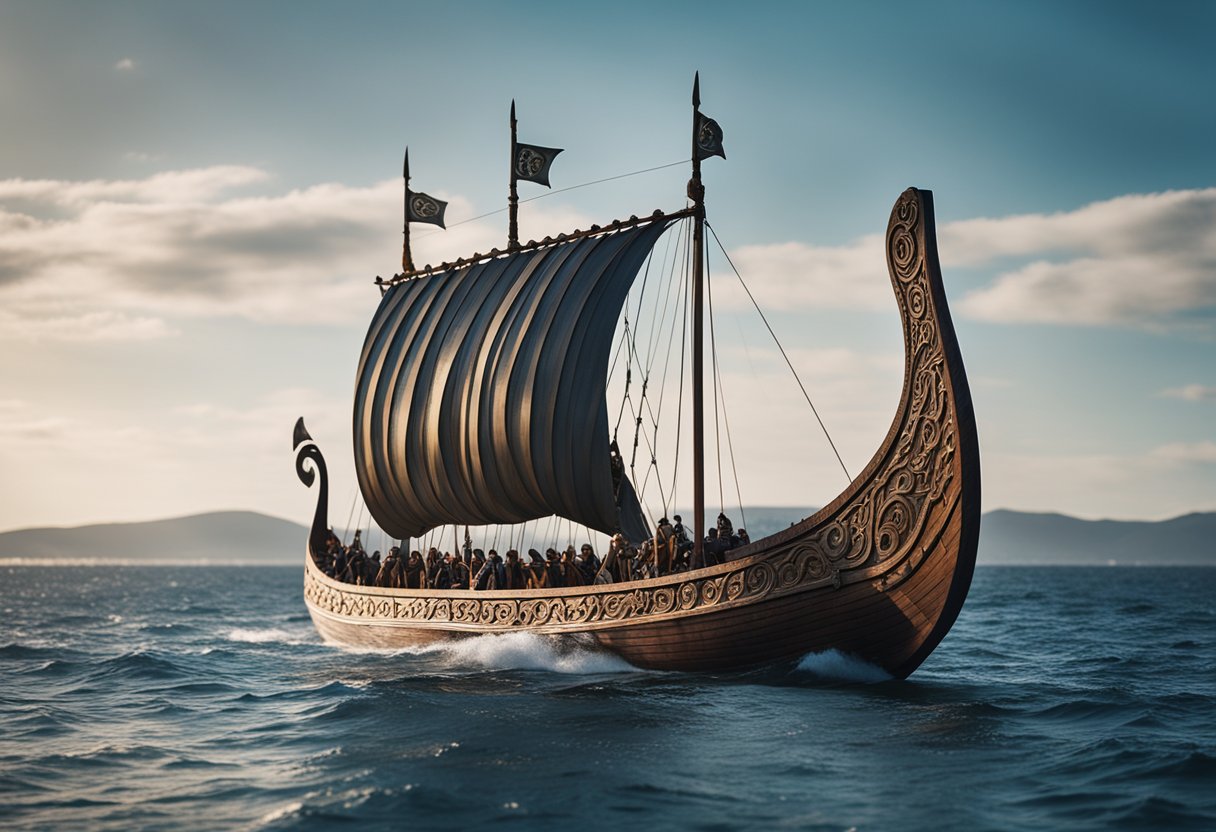
As we explore the annals of history, it becomes evident that Viking trade and expansion were pivotal to their era. The Vikings, known as the Dani in some contexts, demonstrated remarkable adaptability and prowess in navigation. Travelling across rivers and seas, they established far-reaching trade networks.
Their ships were crucial in this regard. Longships, designed for war and exploration, and Knarr ships, fashioned for trade, allowed the Vikings to voyage across treacherous waters. They traded goods such as amber, acquired from the Baltic Sea, and transformed into jewellery and amulets, which were highly prized. Another sought-after commodity was glass beads, whose intricate designs reflected a high level of craftsmanship and were exchanged as far as the Middle East.
The expansion of the Vikings is a tale not just of raiding and conquest but also one of establishing trade routes. Through trade, they connected various cultures, exchanging not only goods but technology and ideas. Their networks spanned from the shores of North America to the trading posts of Byzantium.
Moreover, the Viking expansion was facilitated by their mastery in utilising natural waterways—their longships adeptly navigated both rivers and seas. This allowed them to extend their influence into the heartlands of Europe, reaching cities far from the coast and linking different regions in a web of maritime commerce.
By venturing beyond their homelands, they left an indelible mark on the regions they encountered, allowing us to trace a map of their extensive voyages and the trading connections they fostered.
The Role of the Viking Ship in Burial Rituals
Viking ships played a crucial part in the burial customs of Norse society. They were not merely transported for the living but also served as vessels for the deceased on their journey to the afterlife. Ship burial sites are prominent examples of this practice.
One of the most notable is the Oseberg ship, discovered in Norway, which dates back to the 9th century. This impressive vessel was part of a burial mound and contained two women, signifying the importance of the ship in commemorating individuals of high status. Similarly, the Gokstad ship, found within a large burial mound, was used as a burial chamber for a significant Viking figure, and it underscores the grandeur these maritime people ascribed to their dead.
The Tune ship, another vital discovery, further illustrates the ceremonial function ships had in honouring the departed. These archaeological findings provide an invaluable glimpse into the past, revealing the meticulous craftsmanship and the solemn rituals that surrounded Viking burials.
The reverence Vikings had for their ships is reflected not just in burials but in the resonance these artefacts have had throughout history. Such vessels were essentially floating tombs designed to carry the deceased, along with their grave goods, into the realms beyond our own.
| Viking Ship | Burial Significance |
|---|---|
| Oseberg | Royal women’s burial |
| Gokstad | Chieftain’s burial |
| Tune | Elaborate grave goods |
Our understanding of Vikings’ final voyages has been shaped heavily by these findings. By examining these ships, we gain profound insights into the spiritual beliefs and cultural practices of a society whose maritime prowess was intertwined with their cosmology and societal structure.
Viking Presence in Global History
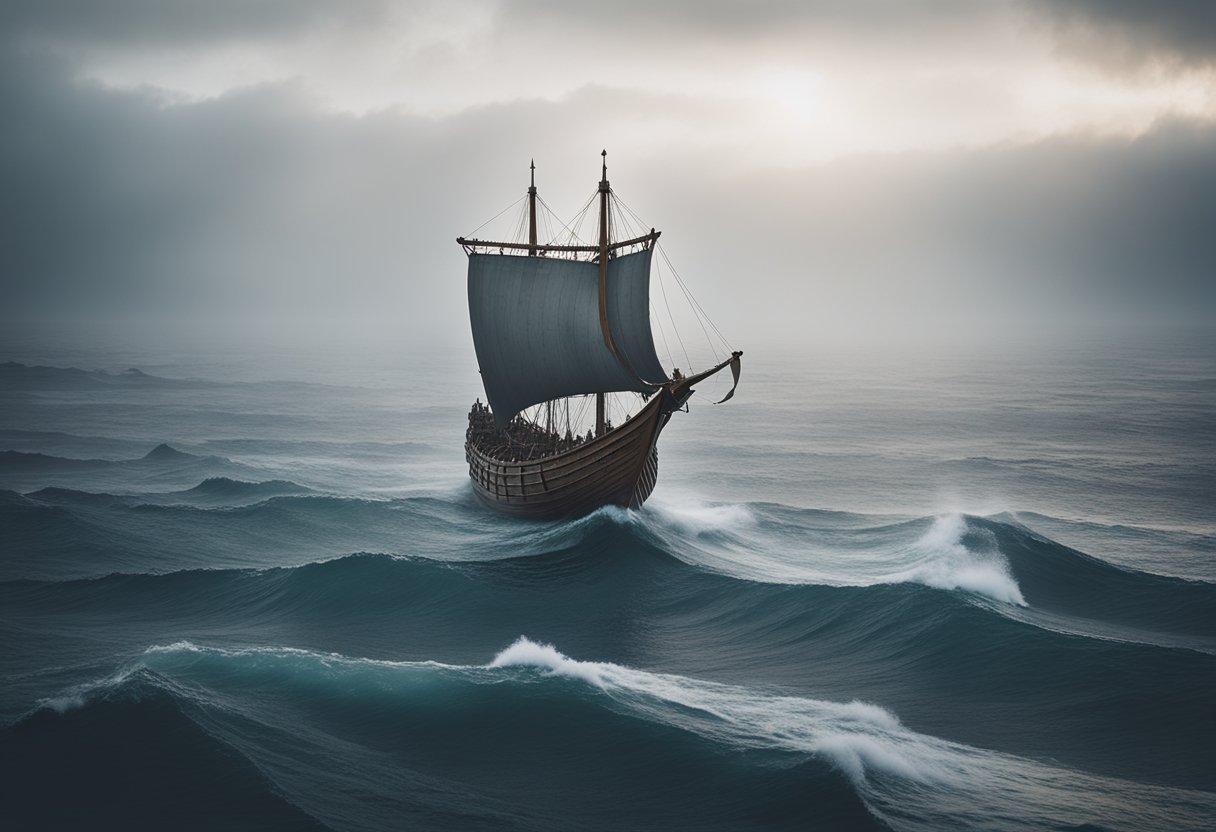
Vikings, hailing from Scandinavia, had a profound impact on global history due to their remarkable capacity for maritime exploration and expansion during the Viking Age, which spanned from roughly 800 AD to 1100 AD. With their advanced shipbuilding techniques, they crafted vessels that were both sturdy and agile, allowing them to traverse vast and treacherous seas.
1. Expansion into the North Atlantic:
- Greenland: Eirík the Red discovered and subsequently settled Greenland, establishing Eastern and Western Settlements.
- Iceland: Notably, Iceland was discovered and settled by Norsemen, primarily originating from Norway and the British Isles. This settlement proved crucial as a waypoint and cultural centre for the Norse diaspora.
2. Ventures to the West:
- North America/Canada: The Vikings voyaged further west to what is today known as Canada, with evidence of their presence found at sites such as L’Anse aux Meadows in Newfoundland, proving they were the first Europeans to reach America.
3. Influence on the East:
- Rus: The Norsemen also ventured eastward, establishing trade routes and settlements, significantly influencing the region of present-day Russia and Ukraine, leading to the inception of the Kievan Rus’.
4. Implications on Global Connectivity:
- America: Although direct impacts on the broader American continent were minimal, the Viking expansion demonstrated the potential of transatlantic navigation that would later influence other European explorations.
- Europe: Throughout Europe, Viking raids, trade, and settlements also sewed the seeds for modern-day countries and influenced the course of the continent’s history.
Our adept understanding of the Viking era paints a picture of a society whose explorative spirit and nautical prowess left indelible marks on history, culture, and the geography of the territories they encountered.
Conservation Techniques and Future Challenges
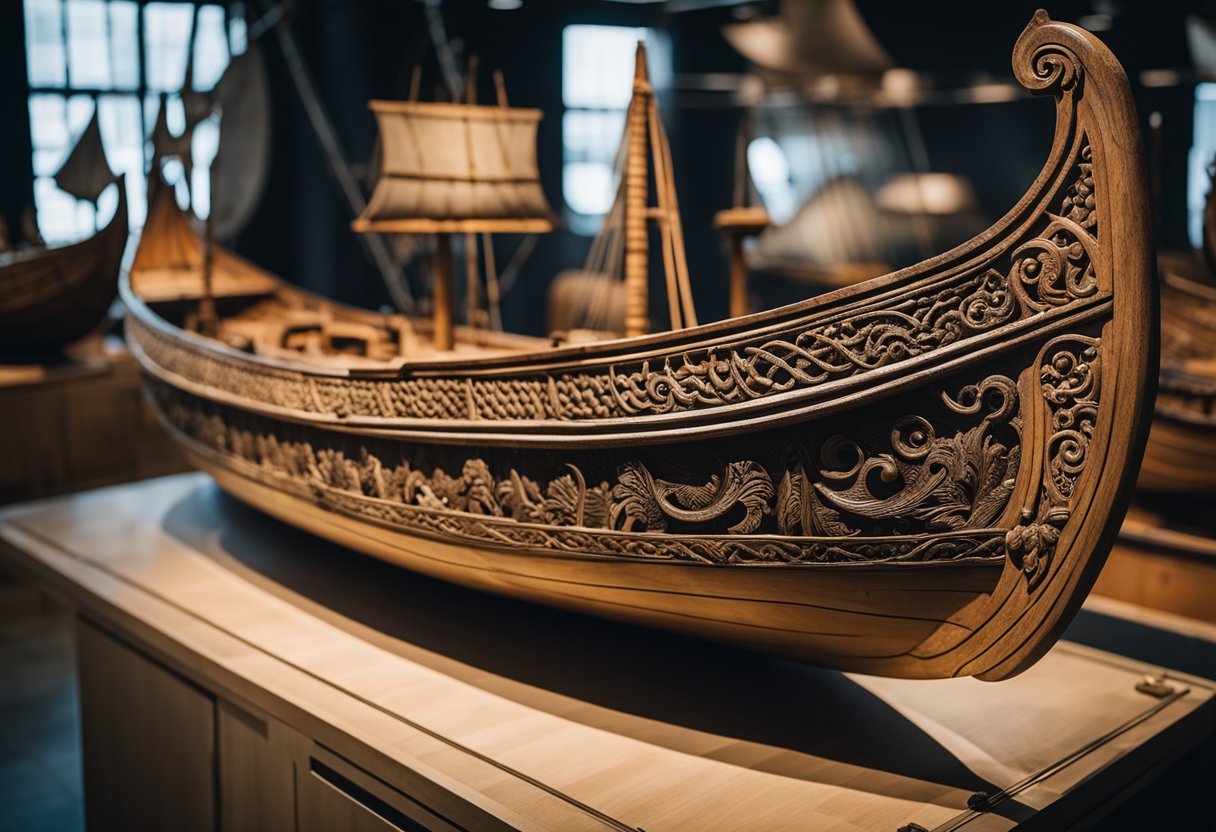
In the field of heritage conservation, the preservation of Viking wooden ships is a task that demands our collective expertise and innovation. These remarkable artefacts, such as the ones preserved at the Viking Ship Museum, present unique challenges due to their organic nature. The timber structures undergo meticulous processes to ensure their longevity, with Professor Gabriel Gustafson playing a pivotal role in the early techniques developed for their conservation.
Traditional Methods:
- The use of tar has been historically significant for the preservation of Viking ships. Tar provides a protective layer that repels water and prevents decay.
- Salt treatments have been used to draw out moisture from the wood, a practice that can be traced back to ancient ship conservation efforts.
Modern Approaches:
- Micromorphology is a contemporary technique aiding in conservation efforts by analysing soil layer samples. This process helps identify invisible remains of wooden objects. Those interested in the intricacies of this method can read about micromorphology investigations to gain a deeper understanding.
Emerging Challenges:
- Climate Change: The increase in extreme weather conditions and rising sea levels present new threats to these historic vessels. Our strategies must evolve to combat these issues and may involve innovative building solutions such as those utilised in the expansion of the Viking Ship Museum in Roskilde.
We are dedicated to continuing these efforts in conservation, ensuring that future generations can access and learn from these formidable artefacts of the Viking Age. The journey of these ships through time is not yet over, and we stand together to face the challenges ahead.
Influence on Modern Design and Craft
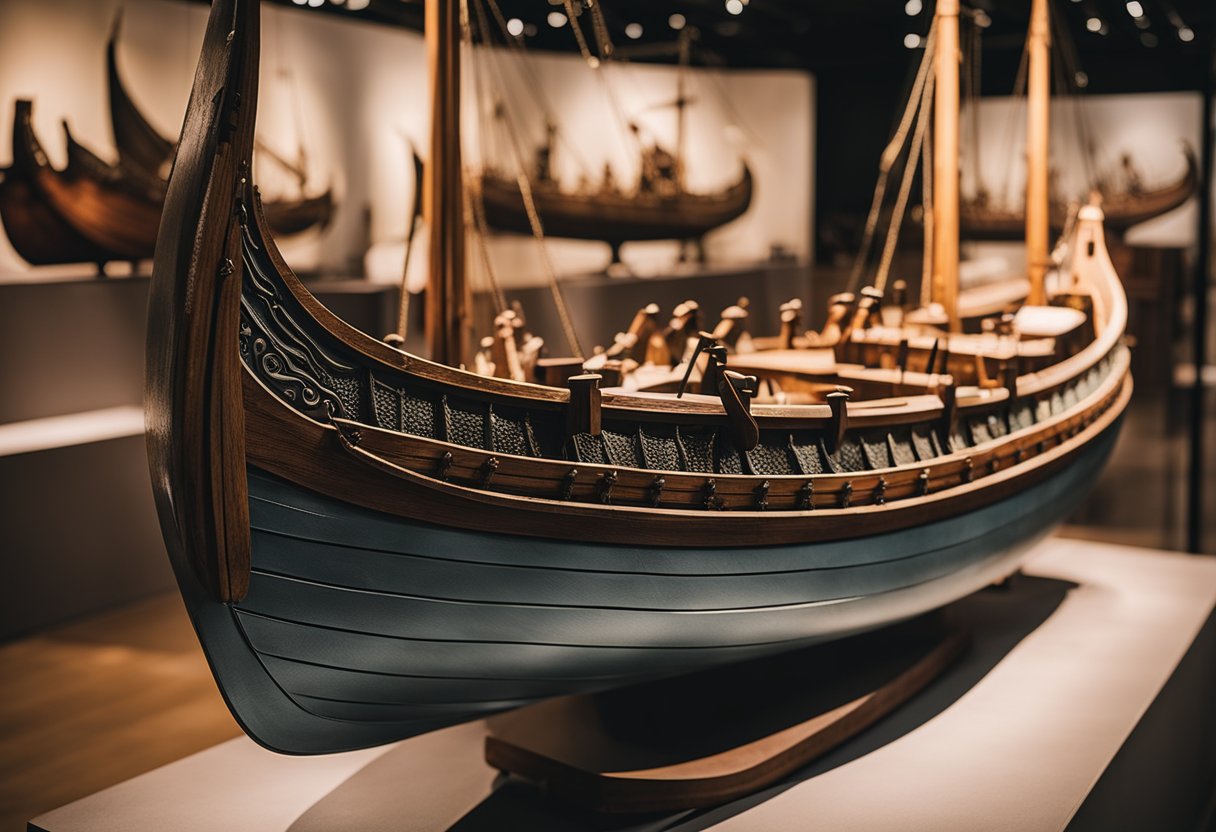
In the realm of design, the robust legacy of Viking craftsmanship casts an enduring shadow. We see motifs from their era, famed for its light and shadow interplay, influencing modern aesthetics. Their lasting impact is evident in architectural competitions where innovation meets history.
Romantic movements of the past have revived interest in Romantic and Gothic styles, with modern-day architects drawing inspiration from the Viking’s meticulous woodworking and stonework. For instance, we draw parallels between the Gothic style’s pointed arches and the prow shapes of Viking ships. These structures encapsulate a subtle echo of the past in contemporary design.
In maritime crafts, today’s builders often seek the simplicity and elegance that characterised Viking shipbuilding. The ships, admired for their balance of form and function, guide today’s craftsmen in constructing vessels that are both aesthetically pleasing and seaworthy.
The Viking influence is also observed in today’s Scandinavian architecture, with structures often featuring minimalist design, functionality, and a harmonious relationship with nature, reminiscent of Viking construction methodology. Their skill in manipulating materials like wood continues to steer modern-day craftsmanship, fostering a timeless dialogue between past and present in our shared cultural heritage.
Frequently Asked Questions
In this section, we’ll address some common queries about the Viking Ship Museums in Oslo and Roskilde. These museums offer a unique glimpse into the maritime prowess of the Vikings and their significant role in history.
What exhibits are featured at the Viking Ship Museum in Oslo?
The Viking Ship Museum in Oslo proudly displays artefacts from prominent ship burial sites, including Oseberg and Gokstad. It houses beautifully preserved Viking ships and provides insight into Viking burial customs and daily life during the Viking Age.
How can one obtain tickets to visit the Viking Ship Museum?
Tickets to the Viking Ship Museum can usually be purchased online from the museum’s official website or at the museum entrance upon arrival. We recommend checking the latest visitor information for updates on ticketing and opening hours.
Which authentic Viking ships from the 9th century are on display at the museum in Oslo?
The museum in Oslo is home to the Oseberg ship, an incredibly well-preserved example of Viking marine engineering. Alongside this, the Gokstad and Tune ships, dating back to the 9th century, are also on display, offering invaluable insights into the era.
What are the main attractions at the Viking Ship Museum in Roskilde?
The Viking Ship Museum in Roskilde is renowned for its five original Viking ships and focuses on the maritime culture of the Vikings. Visitors can see reconstructions and partake in sailing trips to experience Viking navigation first-hand.
Why are the Viking Ship Museums significant for understanding Viking history?
These museums are pivotal as they house the remnants of Viking ships, which were central to their society. They provide concrete evidence of the Vikings’ skilled craftsmanship and their extensive maritime capabilities that led to their far-reaching influence.
How does the Viking Ship Museum in Denmark contribute to the preservation of maritime heritage?
Denmark’s Viking Ship Museum not only exhibits original Viking ships but also actively engages in their restoration and preservation. Furthermore, it works on archaeological excavations and research to enhance our understanding of Viking maritime history.






